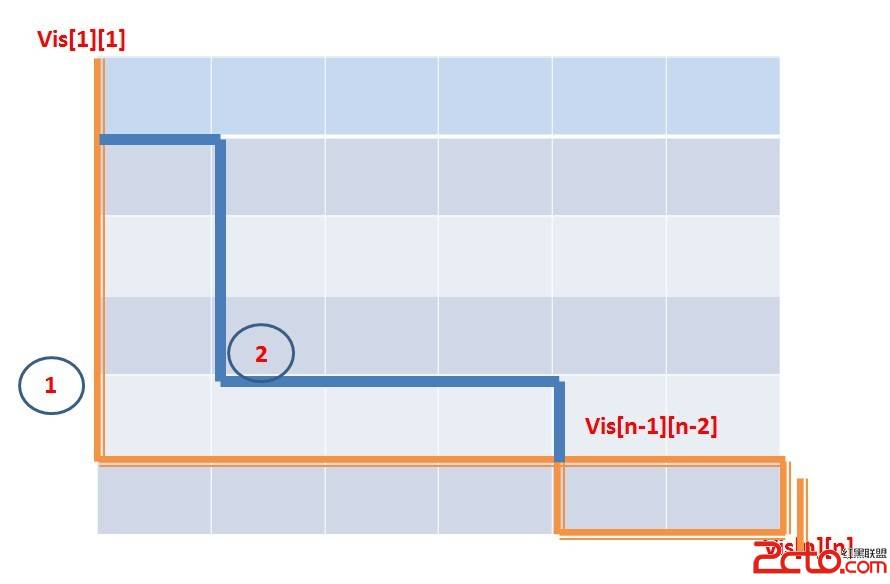Problem Description
LL最近沉迷於AC不能自拔,每天寢室、機房兩點一線。由於長時間坐在電腦邊,缺乏運動。他決定充分利用每次從寢室到機房的時間,在校園裡散散步。整個HDU校園呈方形布局,可劃分為n*n個小方格,代表各個區域。例如LL居住的18號宿捨位於校園的西北角,即方格(1,1)代表的地方,而機房所在的第三實驗樓處於東南端的(n,n)。因有多條路線可以選擇,LL希望每次的散步路線都不一樣。另外,他考慮從A區域到B區域僅當存在一條從B到機房的路線比任何一條從A到機房的路線更近(否則可能永遠都到不了機房了…)。現在他想知道的是,所有滿足要求的路線一共有多少條。你能告訴他嗎?
Input
每組測試數據的第一行為n(2=<n<=50),接下來的n行每行有n個數,代表經過每個區域所花的時間t(0<t<=50)(由於寢室與機房均在三樓,故起點與終點也得費時)。
Output
針對每組測試數據,輸出總的路線數(小於2^63)。
Sample Input
3
1 2 3
1 2 3
1 2 3
3
1 1 1
1 1 1
1 1 1
Sample Output
1
6
******************************************************************************************************************************
題目鏈接:http://acm.hdu.edu.cn/showproblem.php?pid=1428
題目要求問左上角走到右下角有多少條路,要求如題目描述的A區域到B區域最短距離。題目主要地方已在上面描紅。
方法:記憶化搜索(BFS+DFS+狀態記錄)
代碼:
[cpp]
#include<iostream>
#include<cstdio>
#include<cstring>
#include<queue>
#define LL __int64
using namespace std;
LL n,tot;
LL Map[55][55],vis[55][55];//圖,每一點的狀態(有多少條路)
LL dis[55][55];//終點到各點的最短距離
LL dir[][2]={{0,-1},{-1,0},{1,0},{0,1}};//方向
struct Node{
int x,y,step;
};
queue<Node>que;//隊列
void bfs(){//寬搜,確定終點到各點距離
Node now,next;
int i,j;
now.x=n,now.y=n,now.step=0,tot=0;
que.push(now);
dis[n][n]=Map[n][n];
while(!que.empty()){
now=que.front(),que.pop();
for(i=0;i<4;i++){
next.x=now.x+dir[i][0],next.y=now.y+dir[i][1],next.step=now.step+1;
if(next.x<1||next.y<1||next.x>n||next.y>n) continue;
if(dis[next.x][next.y]>dis[now.x][now.y]+Map[next.x][next.y]||dis[next.x][next.y]==-1){
dis[next.x][next.y]=dis[now.x][now.y]+Map[next.x][next.y];
que.push(next);
}
}
}
}
LL dfs(LL x,LL y){//深搜,確定有多少條路可到達
int sx,sy,i;
if(vis[x][y]) return vis[x][y];//路已經走過,返回這點已經有的值(記憶化搜索)
if(x==n&&y==n){//能夠到達終點,多一條路,return 1;
return 1;
}
for(i=0;i<4;i++){
sx=x+dir[i][0],sy=y+dir[i][1];
if(sx>n||sy>n||sx<1||sy<1) continue;
if(dis[sx][sy]>=dis[x][y]) continue;//題目要求選短的路
vis[x][y]+=dfs(sx,sy);
}
return vis[x][y];
}
//主函數
int main(){
LL i,j;
while(~scanf("%I64d",&n)){
for(i=1;i<=n;i++)
for(j=1;j<=n;j++) scanf("%I64d",&Map[i][j]);
memset(dis,-1,sizeof(dis));
memset(vis,0,sizeof(vis));
bfs();
dfs(1,1);
printf("%I64d\n",vis[1][1]);//記憶化搜索,從終點返回,所以是vis[1][1]
}
return 0;
}
特別地,記憶化搜索在什麼地方體現出來呢,
在DFS中,如果把DFS不使用記憶化搜索而改成如下代碼(普通深搜):
[cpp]
void dfs(int x,int y){
int sx,sy,i;
if(x==n&&y==n){
tot++;//tot記錄能夠到達終點的路的條數
return;
}
for(i=2;i<4;i++){
sx=x+dir[i][0],sy=y+dir[i][1];
if(sx>n||sy>n) continue;
if(dis[sx][sy]>=dis[x][y]) continue;
dfs(sx,sy);
}
}
這樣伱就掛了!!TLE,MLE。
再看一張圖,苊對記憶化搜索的最基礎的理解:

深搜的時候是從vis[1][1]開始搜的,第一次直搜到vis[n][n],然後返回的時候可以得到vis[n-1][n-2]那個點的路,當第二次搜到vi[n-1][n-2]這個點的時候就不用往下搜了, 直接加上在這個點的路,OK,節約時間。
作者:madrishing